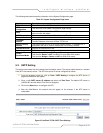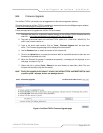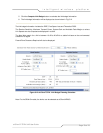
Page 74 of 75
intelligent wireless platform
airClient™ TOTAL 3415 User Guide
Appendix A – Some useful terms and definitions
Acronyms and Abbreviations
MAC Media Access Control
RSSI Receive Signal Sensitivity Indication
SSID Service Set Identifier
DHCP Dynamic Host Configuration Protocol
ACL Access Control List
SNMP Simple Network Management Protocol
SNTP Simple Network Time Protocol
STP Spanning Tree Protocol
TCP Transmission Control Protocol
IP Internet Protocol
WDS Wireless Distribution System
SSID
Each ESS has a Service Set Identifier (SSID) used to identify the Radio that belongs to the ESS. Radios
can be configured with the SSID of the ESS to which they should associate. By default, radios broadcast
their SSID to advertise their presence.
WDS
Wireless Distribution System (WDS) is a system that provides a means to extend the range of Wireless
Local Area Network. It allows the creation of large wireless networks by linking several wireless stations
with WDS links. To create a WDS link, peer MAC addresses need to be exchanged (as can be done
through the Wireless Settings page for 3415-03 Bridge Mode). All stations in WDS should be configured
to use the same radio channel and share the same WEP keys, if they are used. smartBridges radios
functions as a transparent bridge while operating as WDS links.
WEP
According to the IEEE 802.11 standard, Wired Equivalent Privacy (WEP) is intended to provide
“confidentiality that is subjectively equivalent to the confidentiality of a wired local area network medium
and that does not employ cryptographic techniques to enhance privacy.”
WEP relies on a secret key that is shared between a mobile station and an access point. WEP uses the
RC4 stream cipher invented by RSA Data Security. RC4 is a symmetric stream cipher that uses the same
variable length key for encryption and decryption. With WEP enabled, the sender encrypts the data frame
payload and replaces the original payload with the encrypted payload. The sender then forwards the
encrypted frame to its destination. The encrypted data frames are sent with the MAC header WEP bit set.
Thus, the receiver knows to use the shared WEP key to decrypt the payload and recover the original
frame. The new frame, with an unencrypted payload can then be passed to an upper layer protocol.
WEP keys can be either statically configured or dynamically generated. In either case, WEP has been
found to be easily broken.
WPA
Wi-Fi Protected Access (WPA) is a replacement security standard for WEP. It is a subset of the IEEE
802.11i standard being developed. WPA makes use of TKIP to deliver security superior to WEP. 802.1X
access control is still employed. The Authentication Server provides the material for creating the keys.


















